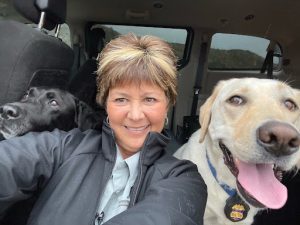Becoming Part of the Solution by Nina Delgadillo
Active assailants, frequently armed with firearms, have become far too familiar in our society. Families now find themselves having to discuss these violent, life-and-death issues with their children.
In this challenging time of increased threats and violence, parents and communities are asking what they can do to prevent shootings and other types of violence. There is no single solution. However, there are ways to help prevent an act of violence, and we can all be part of the solution.
Law enforcement refers to this concept as a “force multiplier,” acting as a team with the same mission. This mission is to keep our children, communities, and nation safe. We need to work together to share information and do so promptly and consistently. If you see or hear something, say something! Alert authorities who may be able to avert an act of violence.
I have spent my entire adult life in public service, committed to protecting the public, engaging in the community, and mentoring youth. I have witnessed the anguish first-hand of a mass school shooting, bombings, murders, and numerous other acts of violence. I empathize with those who struggle to feel safe and who yearn for some solution to this problem.
When I retired from federal law enforcement, I knew my future would include my will to continue sharing empowerment tools with others, including youth, educators, students, businesses, communities, and first responders. Teaching is in my DNA.
Each time another act of gun violence occurs, there are renewed debates regarding firearms laws, the possession of firearms, mental health, and the lack of laws designed to reduce gun violence. When these conversations are presented, I am often asked what should be done to protect families, schools, businesses, and houses of worship. My response is based upon my knowledge and experience as a federal agent, a school safety director, and a risk manager and the relationships I maintain with safety and security professionals around the globe.
Threat assessment, threat prevention, and threat risk mitigation can have a direct impact on reducing gun violence. Schools, businesses, communities, and houses of worship are often soft targets. Each of these sectors should be fully invested in the following topics:
Identifying and understanding types of threats
Identifying the pathway to violence
Recognizing leakage before acts of violence and understanding the need to report critical information immediately
Learning methods to avert violence to prevent threats
Developing skills that can mitigate threat risks
Improving everyday readiness and response
Requesting Threat and Violence Risk Assessments (TVRA)
Developing a thorough, written, all-hazards safety plan
Conducting well planned and coordinated training and rehearsals
All of these will help you avert a violent attack while increasing your ability to survive an attack.
I also encourage parents to learn about the safety preparedness and response plans at their child’s school or college. In the same way, if parents are curious about policies related to academics, sports, arts, and other opportunities at their child’s school, they should also ask specific questions related to school safety.
Here are some areas that parents should consider discussing with the officials at their child’s school:
Ask if they have a reporting system if a student hears or learns about concerning behavior or actions. Talk to your child about how this system works and the importance of communicating their concerns to a school official as soon as they observe or hear concerning behavior.
Offer to be a part of the school’s site safety committee. In California and other states, the final annual Comprehensive School Safety Plan approval requires parent representation, staff, and administration.
Confirm how emergency messaging is delivered, ensure your emergency contact information is current, and ask if the school has a secondary backup method of communication. In a large-scale incident, cell phone service may be negatively impacted, and a secondary means of communication may be necessary.
Discuss Reunification Plans with your children and how they are deployed after an incident. In an evacuation, do not go directly to the school. While this sounds counter-intuitive, realize that you are impeding the route of law enforcement. They will need to have a clear path of travel to respond to the threat, as well as other first responders who need to render medical aid. Parents will be directed to a Reunification Location.
Ask about student release policies. Remember to bring identification when you check your child out since this becomes critical in accounting for all students. Doing this also ensures your child is released to the appropriate person.
Speak with your children about the importance of safety and preparedness, and encourage them to ask questions and share their feelings and concerns. Remember Stranger Danger? Parents nationwide supported this campaign. Reinforce the importance of practicing ways to increase safety in every aspect of your lives at home, school, restaurants, the mall, and houses of worship. Knowledge is power.
Those are just a few tips I routinely share with parents. For additional detailed information, seek more extensive school safety training with vetted professionals. Be sure to research any company you consider hiring thoroughly. The professionals you entrust to assess and support your interests should have real-life experience working with first responders, communities, schools, houses of worship, and businesses. Ask them for specific examples in which they have faced crises and what their roles and responsibilities were in these events. You trust them to enhance your ability to prevent, mitigate, and respond to potential threats, so ensure they have the experience to teach you best practices.
Most importantly, be informed, be prepared, be ready. You can be part of the solution! ❦
About the Author
 Nina Delgadillo is the Director of Safety and Emergency Preparedness at Panthera7 Inc. a retired Senior Special Agent with the Bureau of Alcohol, Tobacco, Firearms and Explosives (ATF). Nina engaged as a master instructor for ATF at the National Academy in Glynco, GA, throughout her career. There, she instructed courses on explosives, undercover investigation (basic and advanced), interviewing, and training the trainer. Nina conducted complex firearms, narcotics, explosives, and arson investigations, domestic and international terrorism investigations, and undercover investigations. Her significant career investigations include the Unabom investigation, the Williams Brothers investigation (arson of multiple synagogues, a reproductive health center, and a double murder), and international terrorism cases following 9/11 with the Joint Terrorism Task Force. Nina’s investigative work has been featured on syndicated shows, including Forensic Files, Investigation Discovery, America’s Most Wanted, and Crimes of the Century.
Nina Delgadillo is the Director of Safety and Emergency Preparedness at Panthera7 Inc. a retired Senior Special Agent with the Bureau of Alcohol, Tobacco, Firearms and Explosives (ATF). Nina engaged as a master instructor for ATF at the National Academy in Glynco, GA, throughout her career. There, she instructed courses on explosives, undercover investigation (basic and advanced), interviewing, and training the trainer. Nina conducted complex firearms, narcotics, explosives, and arson investigations, domestic and international terrorism investigations, and undercover investigations. Her significant career investigations include the Unabom investigation, the Williams Brothers investigation (arson of multiple synagogues, a reproductive health center, and a double murder), and international terrorism cases following 9/11 with the Joint Terrorism Task Force. Nina’s investigative work has been featured on syndicated shows, including Forensic Files, Investigation Discovery, America’s Most Wanted, and Crimes of the Century.
Following her ATF retirement, Nina became director of the Office of Safe Schools in the Sacramento City Unified School District, where she managed a 2.8-million-dollar contract with the Sacramento Police Department and directed the district’s use of an online emergency management system. She also led a team of school resource officers, probation officers, and non-sworn personnel. The SRO team was contracted to the district. It was responsible for maintaining a safe and positive environment for 50,000 students, staff members, parents, and members of the surrounding community.
Nina has been an active speaker at national school safety conferences and an advisor to national school safety organizations. In 2021, she became the Risk and Safety Coordinator for Schools Insurance Group, a Joint Powers Authority, where she provided specialized guidance related to the coordination of various projects associated with risk management and loss prevention for 34 client school
Awards / Recognition:
· Recipient of ATF’s Distinguished Service Medal; four FBI Director Awards; awards from the United States Department of State, Department of Diplomatic Services, the United States Air Force, Office of Special Investigations; recognized by United States Senators Harry Reid and John Ensign
· Recipient of Team Resolution from California State Assembly Member Jim Cooper for Outstanding Efforts in School Safety
· Recipient of State Senator Richard Pan’s Unsung Hero Award
· Recipient of the City of Sacramento’s Champion of Excellence in Education Award
· Recognized by the School Safety Advocacy Council for efforts in advancing school safety
· Member of the National Association of Threat Assessment Professionals
Nina has three children and five grandchildren and resides in Sacramento, California. She can be reached at nina@Panthera7.com.
